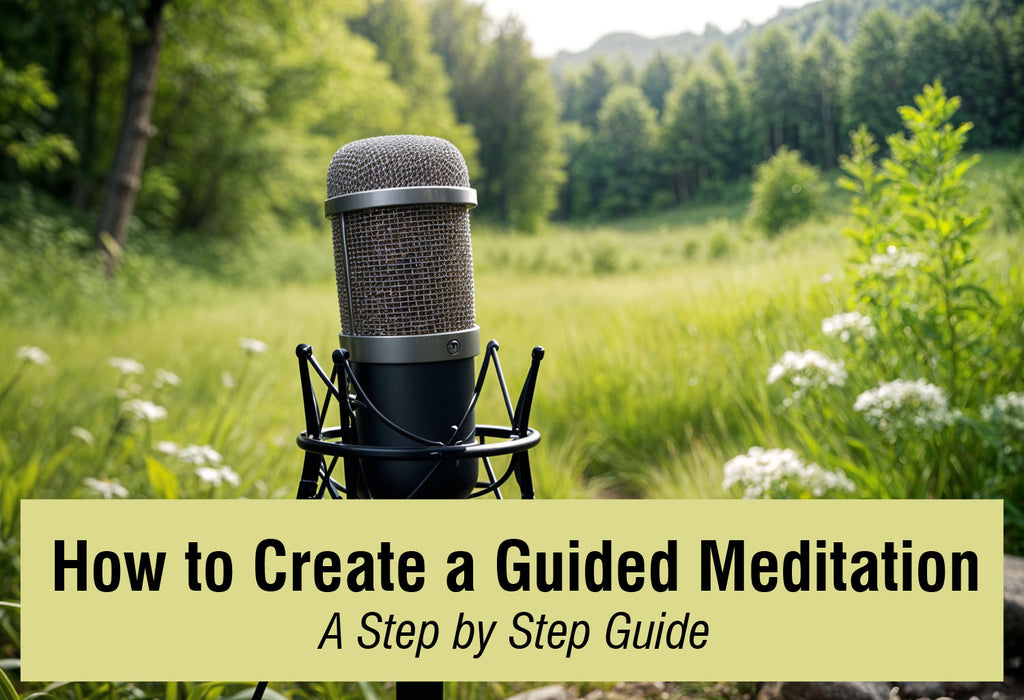A guided meditation is an audio recording that helps you, your clients, a friend, or a loved one achieve a specific outcome through meditation.
Meditation has many wonderful benefits, but like any new skill, can be challenging. The same goes for guiding a meditation. We often encounter familiar mental barriers, such as distraction, mental resistance, or physical discomfort.
This article is designed to teach you how to create, record, and publish a guided meditation. Whether you are a therapist and want to try it with your clients, integrate meditations into your workshops, or simply want to start a business doing what you love.
This guide will walk you through each step to facilitate transformation and healing in the people who will benefit from your guided meditations.

Step 1: Prepare Yourself
Before preparing your meditation, I recommend that you explore your favorite meditation teachers or audios, engage in those guided meditations yourself, and be very conscious of your whole experience. What did you like? What did you feel comfortable with? What would you have changed?
This will help you in the creative process of writing the script for your own guided meditation, ensuring that it is completely authentic and aligned with your unique style.
Step 2. Pick the Desired Outcome of Your Meditation
All meditations have essentially the same purpose: to expand our consciousness, reduce stress, feel more aligned, etc. But to reach these broader goals, it is important to clarify a more specific outcome of the meditation you want to guide.
Doing so will help you determine the length as well as the type of words, images or resources you want to use to reach that specific goal.
The outcome of your meditation could be to reduce anxiety or improve sleep, help the listener be more connected to the present moment, increase self-compassion, enhance attention and focus, and more.
Step 3: Structure Your Guided Meditation
All meditations have a kind of natural flow. However, if you are starting to create your guided meditations, it helps to structure them. This helps to make your script more effective and lead to the desired outcome.
The Beginning
The beginning of the meditation aims to prepare the client for the experience. To do this, it is important to briefly explain the purpose of the meditation to set the tone and intention of it. By doing so, all participants will feel comfortable and aligned with the purpose of the guided meditation.
During the first few minutes, provide some key instructions such as what posture to have, how to manage breathing, or what participants should do if they feel distracted (I usually say the following: imagine that your thoughts are like clouds drifting in the sky. Don't get caught up in them. If you do get caught up, gently refocus on your breathing).
Another technique I use at the beginning of the session is to invite clients to do a body scan of the different parts of their body, from head to toe, to notice any tension or discomfort. In my experience, this sets them up for the next part of the meditation.
Write down exactly how you would guide clients through the beginning of your guided meditation, using your own words and style. Focus on being authentic rather than getting it “right.”
The Middle
Once the participants have been focused on their breathing for a few minutes, it is time to introduce the catalyst that will lead them to the desired outcome of the meditation.
In this part of the script, write down how you would guide your clients through a visual journey. Natural settings such as a forest or a lake are often more effective. They connect us to a state of greater relaxation and openness to the unknown.
Next, introduce the catalyst for transformation. This can be an encounter with the client's inner child or future self, a scenario in which the client realizes something they deeply long for, or even a thought-provoking question (e.g., what am I trying to control? What am I tolerating?).
After introducing the transformational catalyst, allow a moment of silence for clients to go through their experience at their own pace. Depending on your style, you can play background music to enhance the meditative state.
The middle part is usually the most intense and vulnerable. As guides, we sometimes rush through this part because we are uncomfortable with these difficult emotions. Other times we just want the client to feel better quickly. However, it is extremely important to breathe and take the time necessary to live this experience as deeply as possible.
The Ending
The last part of the meditation aims to help clients return to the present moment. Encourage them to become aware of the sounds around them, how the back of the chair or the mat they are on feels. Then, invite them to make some soft, gentle movements, such as wiggling their fingers or toes, or moving their neck slowly.
Invite the client(s) to open their eyes at their own pace. I always end meditations by asking clients to share one or at most two words from their experience. Others invite clients to briefly share what they experienced or to write it down as homework.
Step 3: How to Write a Meditation Script?
Now you are ready for the creative part: writing a meditation script. All you need to do is follow the structure above, make it your own, and start putting your words to it. Before delving into the process, here are some tips.
Use clear and simple language that even an elementary school child can understand. We do not want the mind to become fully engaged in the content of the meditation, but rather to use your guidance as a vehicle for transformation.
Along the same lines, remember that more is less. The fewer words you use to achieve your goal, the better. Guided meditation has to take you to a more relaxed state, connected to the present moment, so it is important to leave spaces between each word and keep a slow and calm pace.
Lastly, don't forget that meditation can lead people to connect with strong emotions or vulnerable spots within their inner selves. Be compassionate in your tone and promote a safe environment so that your clients feel encouraged to go deeper.
Step 4: How to Record Your Meditation
Once your script is ready, you can turn it into an audio file to grow your audience. Recording your meditation several times will help you see what you should change or improve. So, don't get frustrated if it takes longer than expected. This is part of the process of removing unnecessary words and fine-tuning the details. Focus on good timing and a calm and compassionate tone rather than perfection.
You can use timing notations such as “(...)” or “(pause)” in your script at the end of certain words or sentences to indicate that it is a time of further pause, contemplation, or relaxation.
Here are the tools and techniques you need to create effective meditation recordings:
Microphones & Recording Software
Reading this may sound overwhelming, but believe me, you don't have to go broke to get the right equipment. You can buy a USD microphone that can have clean noise and audio quality for less than $100. For details, you can read our article: 5 Best Microphones for Recording Guided Meditation

After you do some market research and choose your microphone, you need a “digital audio workstation” or DAW. This software is where you will be able to record and edit your meditations. Audacity, GarageBand and Reaper can all be excellent choices which are also free. I personally recommend Audacity as it is very straight forward to use, and it is available for both Mac and Windows users.
Select a Room That Absorbs Sound
Record your meditations in a room with soft materials such as rugs, carpets, or sound-absorbing couches. Your bedroom or a closet may be a good option. If you are on a budget, you can also buy acoustic foam or create a pillow fort to block background sound.
Tips on how to Record Meditations
Here are some tips for you to record your meditations like a pro.
- Keep your microphone 5 inches away from your mouth.
- Pause when you need to move, drink water, or adjust your seat. This will make the editing process easier.
- If you make a mistake, clap once so you know when to make adjustments in the editing process instead of starting over.
- Remove background noise. Learn how to do it in our article: How to Remove Background Noise From Guided Meditation Recordings Using Audacity.
- Add royalty free background meditation music. You can purchase one from our Meditation Music Library, which has over 200 pieces of meditation music.

Step 5: How to Publish Your Meditation
Insight Timer stands out as the premier platform for meditation, thanks to its specialized focus in this field. It's an audio-only platform that boasts over 50 million listeners, essentially functioning as a "Spotify for meditation" where anyone can upload their sessions. While you have the option to share your meditations on audio-centric platforms like SoundCloud or various podcast platforms, including Apple Podcasts and Spotify, Insight Timer offers a unique space dedicated solely to meditation enthusiasts.
Additionally, if you prefer video, you can convert your meditation sessions into video format and publish them on platforms like YouTube, TikTok, Facebook, and Instagram Reels, where different monetization options through ads, sponsored content, subscriptions, or memberships are available.
In Closing
Creating, recording and publishing your first guided meditation can be a journey full of ups and downs. But the satisfaction of offering help in an authentic and personalized way is worth it.
Remember, practice makes perfect. Keep this guide in hand every time you create a new meditation until you become a pro in this beautiful and transformative field.


Thank you so much for this article. It couldn’t have come at a better time. I’ve just done my first live fb guiding people through a meditation during a book launch. I would now like to record it and add your music to it, but I needed guidance. I have downloaded audacity but haven’t yet worked it all out. Thank you for writing this article.
I think the most important thing when creating a meditation is the vibration and energy of the track, you want it to come from the soul rather than too much of the head. So it is important to go deep into your heart and soul before and during the creating and channeling process